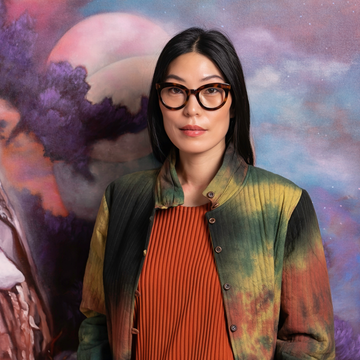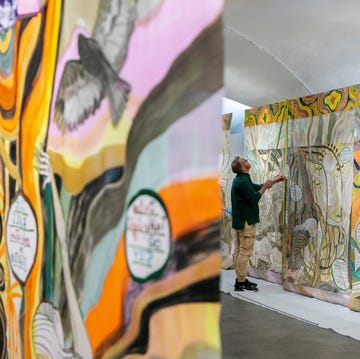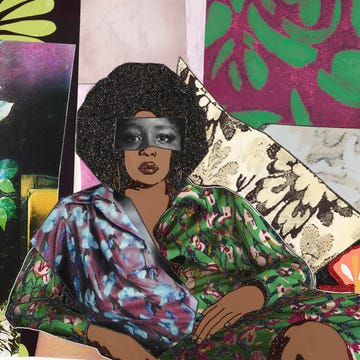On a grey, wet London morning last summer, I took the no.1 bus from the end of my road, straight down Great Russell Street.
I was to sit for the painter Celia Paul and due to arrive at 9am, wearing plain clothes. Sifting through my wardrobe – which mainly consists of corduroy suits, striped tops and shirts with giant bows – it was difficult to find something quite right. If you’ve ever seen Celia's paintings, you’ll know that her figures appear ethereal. They’re often self-portraits – or portraits of those close to her (she is one of five sisters) – dressed in spattered-painted smocks, or long Victorian nightgowns. Her subjects are bathed in a sepia, grey/green-toned glow. It’s as though they’re devoid of time, context or place. They exist in the world of Celia Paul, where time is slow, the light is intense, and gazes are sharp, quiet and powerful.
I left my house after settling on a white linen dress, overlaid with a cream silk shirt (I added a bow, but, unsurprisingly, was later told to take it off).
I’ve sat for artists before – most commonly Chantal Joffe. But when I sit for Chantal, whose studio I’ve been visiting for the past five years, we chat non-stop (she knows everything about my life), play music, and eat jammy dodgers and thin slices of cheese. Knowing Celia, I suspected things would be different.
I was excited: Celia hardly ever paints anyone other than her family. But I was also daunted. To prepare, I emailed her to ask how she works. “In silence”, she replied. I’ve known her for a long time: I started out working on the front desk of the gallery that represents her when I was 18, and later interviewed her for my podcast The Great Women Artists. But it didn’t detract from the fact that I felt incredibly nervous – and had done all week.
I think it was the prospect of that word: silence. Me, sitting there, alone, with my thoughts, and worrying about how I’d claw myself out of them. I'd been feeling unmoored after a difficult emotional period, and had been using my work as a distraction from confronting it, and the last thing I reckoned I needed was time to think – or overthink.
On the bus I googled: “how to sit still for 10 minutes”, “…30 minutes”, “…1 hour”. It might sound funny to some people, but the idea of sitting still fills me with terror. Too often we trick ourselves into thinking that we can’t be alone with our innermost feelings.
I got off the bus and paced down the street – past the psychoanalyst offices housed in the rows of Georgian terraces, a suite of UCL buildings, tourist cafés and shops that sell Union Jack cushions. It’s also home to the British Museum, and, as I was already half-way down the road by 8.52am, I had some time to spare to look up and stare at this giant institution. I didn’t bring an umbrella, or a coat for that matter, and the rain was pouring down on me. But it didn’t matter, I love standing in the rain.
Other than that, I was pretty much alone, standing in front of that looming, wide-facaded Neoclassical temple of knowledge. I didn’t know at the time, but Celia was looking down at me from her top-floor flat which faces the museum. It measures eye-level with the facade’s triangular pediment that’s punctuated with recognisable figures from mythology, from an Athena-like figure, with her spear and helmet, to wolfhounds on a leash.
I rang the bell, Celia buzzed me in and I walked up the stairs. It’s an unusual building: some of the flat entrances look imposingly grand, with double doors and gilded handles, whereas others feel like they’ve been occupied by the same people forever. I get a sense of when I’m near because of the all-consuming smell of paint and linseed oil that seeps into the hallways.
As I turn into the last balustrade, I see her smiling face. Celia greets me with warmth. Closing the large wooden door behind us, we walk into her flat. It’s of a modest size, maybe two bedrooms. There is paint on the skirting board and battered doors; the walls are filled with scribbles – telephone numbers, words and occasional drawings.
She’s lived here for about 40 years. It was bought for her by former lover Lucian Freud, who was much older and had been her tutor at the Slade School of Art. She talks about him in her fantastic memoir, Self Portrait. (I also recommend her book Letters to Gwen John.)
As she said on my podcast a few years ago, she doesn’t really believe in the need to own possessions, so there’s not much there. The main room – where we sit and chat for a bit – is made up of a bed, an old green chaise longue, a wooden chair, and a kettle, two mugs, milk, teabags, and two bottles of San Pellegrino.
It was lovely to see her. I don’t know why I had been so nervous. As soon as we settled into chatting, I immediately relaxed. We spoke about our families, writing, our favourite artists and shows that we’d seen. We joked about how she’s more than double my age, but that intergenerational friendships can still be just as strong. I told her about the children’s book I’d just written, and she said how much she would love to give it to her granddaughter, Eve.
Thirty minutes had passed us by. Now it was time to paint.
We walked into the next room: her studio. I’ve never known a place to feel so sacred. Being inside, I felt transported to the inside of one of her paintings – or a memory or picture that might exist at the back of her mind. The semi-translucent blinds were down, so a yellow celestial light poured through the room, with a hint of the shape of the building outside. It created a hazy, foggy glow. Canvases turned away from us, so you could only see the back crosses that keep them stretched, bar one small-sized canvas that rested on an easel, ready to be worked on. It sat beside a palette she must have prepared before my visit: creams, blacks, blues and crimsons, and thin, dainty paintbrushes ready to be used.
She sat me down on a paint-splattered chair, and told me to look towards the window. She opened the blind as she thought it would be nice for me to have something to look at. She was right. There it was: the British Museum, the keeper of history, an emblem of patriarchal power and colonial rule that was most recently embroiled in a scandal of stolen objects, looming over us. While the institution has its own complicated history, Celia and I spoke about how hopeful we felt about the appointment of Nicholas Cullinan as its director. As if it’s entered its new era.
Then it was time to start. And there it was: silence.
Just as I was ready to be hit with a tidal wave of thoughts, voices and emotions that I felt petrified to have trapped my head, something sort of magic happened. As she began to paint my head started feeling lighter, focussed, concentrated.
I had to stay in the same position for a while, but I had fun in that mode. My eyes must have been darting across a little bit as I analysed each figure on the museum’s pediment with acute detail, and occasionally caught quick glimpses of her at work. To see an artist working is one of the most extraordinary experiences – it’s like seeing someone immersed in a trance. I also caught sight of the scribbled notes on the wall next to the back-turned canvases: names of paint colours repeated, and postcards of Emily Dickinson, Gwen John, and small reproductions of her portrait of her mother.
Then I gazed at the light. It was both bright and gloomy at this point – the sky couldn't make up its mind about the weather – and the sun kept hitting the brown Portland stone in different ways. Sometimes the shadows were angular and sharp, and other times they were soft. It was fun testing myself when they would flit between the two, it felt like a whole theatre in front of my eyes. As it had been raining, water had stained the bricks – the textures reminded me of Rothko, or the scrub-like marks Joan Mitchell used in her early paintings from the 1950s.
I lost all concept of time. Celia was so quiet, so unobtrusive that I barely even knew she was there. Sometimes I even forgot. I was in my own world. In a way, I didn’t want it to end.
Sitting for her, in her sacred enclave, felt so special, like I was wrapped in this calm, otherworldly glow. Occasionally, I’d be reminded of the default café noise from the people on the streets below. I kept looking between the museum – the tip of the geodesic-domed roof – and the sky, and marvelling at the flying birds and smokey clouds that careened at both slow and fast paces. At one point, two heart shaped clouds appeared. I cracked a smile. I wondered if Celia noticed.
I don't know how long I sat there for, but being there, in silence, felt good. I was faced with confronting my thoughts, but the funny thing was, they didn’t even bother to come in. The way we overthink is such a waste of time. Why do we do this to ourselves when we can just marvel at nature, or stare at the theatre of clouds and the textures on buildings? Suddenly, when you see all of this, you realise how much you miss.
‘Celia Paul: Works 1975–2025’ is out now, featuring contributions by Hilton Als, Karl Ove Knausgard and more, and a conversation between Katy Hessel, Celia Paul and Edmund de Waal.
Paul will be in conversation with Katy Hessel and signing copies of the book at Foyles on 9 April. Tickets are £10 or £150 with a book.
‘Celia Paul: Colony of Ghosts’ is at Victoria Miro Gallery, London N1, until 17 April.
















